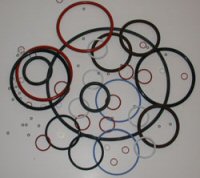 O-rings are one of the most common seals used in machine design today. A mechanical gasket in the shape of a doughnut, an O-ring is a loop of elastomer with a round cross-section, designed to be placed in a groove and compressed during assembly between two or more parts, creating a seal at the interface. They are inexpensive, easy to make, and reliable. Like everything though, O-rings sometimes fail or break, and need to be replaced. O-rings can fail for a variety of different reasons. Today we discuss some characteristics that help us identify a damaged O-ring material, causes of failure, and when they should be replaced.
O-rings are one of the most common seals used in machine design today. A mechanical gasket in the shape of a doughnut, an O-ring is a loop of elastomer with a round cross-section, designed to be placed in a groove and compressed during assembly between two or more parts, creating a seal at the interface. They are inexpensive, easy to make, and reliable. Like everything though, O-rings sometimes fail or break, and need to be replaced. O-rings can fail for a variety of different reasons. Today we discuss some characteristics that help us identify a damaged O-ring material, causes of failure, and when they should be replaced.
How to Identify a Damaged O-Ring
If your O-ring is not performing as you expected, and there is no visual damage, it does not necessarily mean you have a damaged one. It could just mean you have the wrong size O-ring for the application you are using it with. Once you confirm the appropriate size, here are some troubleshooting tips for identifying damaged O-rings.
- Develops circumferential splits within the flattened surface. This is usually due to excessive compression.
- Exhibits blisters, pocks, or pits on its surface, due to rapid pressure changes.
- Exhibits small cuts, nicks, or gashes. This is typically from installation damages.
- Exhibits a flat surface parallel to the direction or motion. Loose particles and scrapes may be found on the seal surface, due to friction from a rough sealing surface.
- Develops ragged edges that appear tattered, typically due to excessive clearances.
- May exhibit radial cracks located on the highest temperature surfaces. In addition, certain elastomers may exhibit signs of softening. This is due to exposure to excessive heat.
- May exhibit many signs of degradation including blisters, cracks, voids, or discoloration, due to chemical incompatibility.
Any of the above conditions warrant the replacement of your O-ring. A good rule of thumb is to replace them once a year.
When It’s Time To Replace Your O-Rings
When it’s time to replace your O-rings, Manufacturer’s Rubber & Supply has you covered. Not only do we carry a wide variety of O-rings and O-ring material, but we also carry an abundance of resources that will make your job even easier. Contact us at Manufacturer’s Rubber today to speak with our experienced team!

